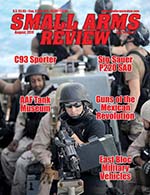By Robert Segel
Fort Nelson was built in the 1860s, as part of chain of fortifications protecting the great naval harbor of Portsmouth in Hampshire, England, and its Royal Dockyard from a feared French invasion. Covering nearly 19 acres and now fully restored, Fort Nelson sit majestically atop Portsdown Hill, with amazing views of the Solent and Meon Valley. The Fort stands today as a monument to the skills and ingenuity of Victorian engineering and architecture. Opened in 1995 as home to the Royal Armouries collection of artillery, Fort Nelson, named after Lord Nelson, hero of the battle of Trafalgar, has over 350 big guns and historic cannon on display.
Before Fort Nelson was built, Portsmouth's defense relied upon smoothbore guns positioned close to the shore. Portsmouth Harbor is a large, natural port in the south of England. To protect Portsmouth from newer, larger and more potent guns, it was necessary to redesign all of the fortifications around Portsmouth. In the 1850s the English government decided to update the forts on the Isle of Wight, the mainland and the Solent and they also built four sea forts across the eastern approach. It was feared that the French might try to come and attack over land so a line of forts were built along the Portsdown Hill - one of which was Fort Nelson.
Fort Nelson was built between 1862 and 1871 and the guns of the fort faced inland, not out towards the sea. The guns were manned by a garrison of 200 volunteers and the forts along Portsdown Hill were never attacked. High walls and towers were easy to knock down by siege guns so Fort Nelson was built low with earth slopes facing the attacker, with slopes hiding the guns and musketry positions.
In 1902, the garrison was stood down and the armaments removed although it did still continue as a military depot. It was used as a transit camp for soldiers going to France between 1914 and 1918 in World War I. Although the fort never saw action against the French, it did against the Germans. Prior to World War II, Fort Nelson became an important anti-aircraft magazine supplying ammunition (40mm Bofors and 3.7-inch rounds) throughout the South Coast with an adjoining anti-aircraft battery that was one of the important batteries preventing enemy aircraft from flying inland from the Channel. On the night of January 9, 1941, the fort was bombed by enemy aircraft. They were commended for supplying a further 1,220 rounds of ammunition to the AA batteries' guns despite being under heavy fire. As it was being used as an ammunition base, its own anti-aircraft guns were placed outside its walls. The fort continued to serve as a naval depot until the 1950s. It was then restored before being leased to the Royal Armouries in 1988 and opened to the public.
Fort Nelson is a historic monument, restored to how it would have been in the 1890s. Visitors can access most areas of the fortification and see how the fort would have worked. The aims of the displays around the fort are to give an idea of how the fort would have been used and lived in, based on an 1890s date as by then most of the physical changes to the fort had taken place; to enable key examples of the fort's armament to be demonstrated by dedicated volunteers, and to interpret the changes to the fort as the result of a major change of use from 1938 when it was used to supply anti-aircraft ammunition to batteries in the large area of Southern England.
The Tower of London used to house all of the arms and armor, including artillery, since medieval times and contained historic examples from throughout England's history. Ultimately, the collection grew to the point where the Tower of London was no longer able to properly display a representative collection of artillery. However, the Royal Armouries discovered that Fort Nelson, which had been bought for restoration by the Hampshire County Council in 1977, was a perfect location to move the artillery collection. They leased the Fort and in 1995 Fort Nelson became a fully established artillery museum and historic monument.
Within the barracks are displays of historic cannon and artillery pieces; many of which were captured during their reign as an Empire, with many exhibiting ornate artwork as part of the gun's decorations. A large structure located between the two surviving World War II magazines contain large exhibits that are too large to be displayed in the barracks. These exhibits follow artillery development from the earliest times to the later 20th century. The chronological layout is divided into specific kinds of artillery. Naval guns, field artillery from smoothbore to quick firing, anti-aircraft, with examples of the infamous German 88 and the dependable British 3.7-inch, anti-tank. There is also a rare German Gerlich "squeeze-bore"; recoiless; and self-propelled guns in the form of the British "Sexton 25 pounder. There are pieces from the First Gulf War, including a captured GH-N 45, the long gun-howitzer designed by Gerald Bull. Confronting the visitor upon entry are the Great Turkish Bombard and Bull's Iraqi "Supergun" tubes of 1,000mm and 350mm calibers.
Fort Nelson is currently undergoing a £3.5M development of its galleries and fortifications and is scheduled for completion in 2011. Fort Nelson is located just a short distance from the town of Fareham and Portsmouth. Admission is free. Operating times in the summer (April-October) is daily from 10 am to 5 pm except Wednesday 11 am to 5 pm and in the winter (November-March) daily from 10:30 am to 4 pm except Wednesday 11:30 am to 4 pm. Fort Nelson is closed December 24-26 inclusive. Further information can be found at www.royalarmouries.org/visit-us/fort-nelson.
This article first appeared in Small Arms Review V14N11 (August 2011) |
| SUBSCRIBER COMMENT AREA |
Comments have not been generated for this article.
























